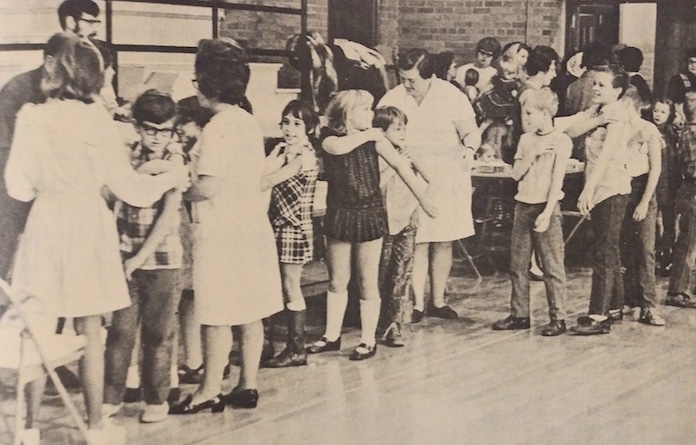Dealing with disease, through history

While the COVID-19 pandemic has impacted Monroe County and the entire world more than any public health crisis in the past century, outbreaks of diseases are nothing new.
Here’s a look through the archives of Monroe County newspapers at different instances of diseases of concern and how they were dealt with.
With the exception of the Spanish flu, none of the public health concerns from 1870 to present day came close to the simultaneous worldwide incidence of COVID-19; nonetheless, strict preventative measures were put in place to prevent spread in local communities.
Before illness-inducing bacteria and viruses were fully understood or vaccines could be developed, the effects of polio, measles, mumps, rubella (German measles), smallpox, diphtheria, typhus, scarlet fever and cholera prompted a range of reactions from the community.
Often, public health officials or law enforcement officers would place signs on the doors of houses with infected individuals. The person who placed the sign was the only one with the authority to remove it.
Other times, depending on severity of the disease or how widespread an outbreak was, public events and school would be canceled to prevent further spread.
An example of several of the methods combined is found in the Feb. 3, 1928 Waterloo Times.
Due to the “continued prevalence of smallpox in Monroe County,” the Monroe County Board of Commissioners established “rigid control and quarantine regulations relating to this disease and other contagious diseases.”
The commissioners were considered the legal health officials of the county at that time, and made a point to have the regulations of the “(Illinois) State Department of Health” published in local newspapers.
Seven main points were communicated to the public. The first was that all people “having knowledge of a known or suspected case” of a contagious disease were to report in writing or by telephone, to “local health authorities” George Niebreuegge, George Toenjes or Henry Mohme.
If a person was found or suspected of having smallpox specifically, a red quarantine sign was to be “placarded warning persons to keep out under penalty of a $200 fine.”
Quarantine of the confirmed cases was “maintained for a minimum of three weeks from the onset of (skin) eruptions” until evidence of the disease was no longer present.
No person, “except he be physician, preacher or public health official” was able to legally enter a quarantined residence.
Every person who came in contact with a person who had smallpox was required to “be vaccinated within 48 hours of first exposure,” submit to quarantine of self and household for 16 days or show proof of “having been successfully vaccinated” within the past five years.
Further, schools were not allowed to let any teacher or student who had smallpox to return “except on presentation of certificate showing recovery from smallpox or successful vaccination.”
Public or church funerals of “persons dead from smallpox” were not allowed at the time, as well.
While the smallpox vaccine was available in 1928, it was still in its rudimentary form and was not as effective or reproducible until advancements in the late 1940s led to another vaccine breakthrough in the 1960s and a subsequent worldwide eradication campaign.

For diseases caused by bacteria prior to the 1950s, vaccinations were either not created or not available.
To prevent the spread or avoid contracting some illnesses, in some cases residents would evacuate entire areas until it was deemed safe to return.
That happened nearby with one of the earliest health concerns found in the Waterloo Advocate: cholera.
In September 1873, 23 fatal cases of cholera were reported from nearby Okawville, Mo.
The St. Louis Globe reported “all that can leave town are going” in response to the wave of cholera-related deaths.
The Waterloo Advocate also reported outbreaks in central and western Kentucky, with at least one county fair being canceled as a precaution.
Twenty years later, cholera was again on the minds of locals, with cases being reported in Europe, New York and Chicago, but none near Monroe County.
The reason such faraway cases were reported in a Waterloo newspaper probably had to do with an outbreak in St. Louis during the late 1840s which killed nearly 5,000 people.
By the mid-1890s, though, it was well-known that the spread of cholera could be easily contained or eliminated by ensuring drinking water is clean and practicing good personal hygiene.
Other mentions of the disease throughout the 1900s was mostly limited to agricultural concerns about cholera in swine and poultry.
The same preventative measures to avoid cholera were also effective against typhoid fever and other bacterial infections. Nevertheless, from 1915 through the end of the 1920s, there were several outbreaks of the disease within Illinois and several deaths in Monroe County attributed to illness from typhoid.
One such outbreak happened during 1925 in Waterloo and Columbia in February 1929. Several cases were reported and at least one person, a 44-year-old Columbia resident, died from the disease in 1929.
Despite knowledge of how the disease spread by the 1920s, contaminated water still led to illness.
Even an issue of the Columbia Star as late as 1957 warned against tyhpoid and the dangers of water being contaminated during transport.
Another cause for the continued spread of typhoid was the absence of mandatory milk pasteurization. Typhoid and other bacterial diseases can be spread through contaminated dairy products.
Even though the United States Public Health Service drafted model ordinances for “recommended” pasteurization policy in 1924, the process did not become a nationwide policy until the Food and Drug Administration limited interstate transport of unpasteurized dairy in 1987.
A 2009 review estimated that 25 percent of all food and water disease outbreaks in 1938 were caused by milkborne causes, preventable by pasteurization.
The Oct. 12, 1938 Waterloo Republican reported “nine homes at Chester are quarantined for scarlet fever … among children ranging in age from 3 to 10 years. One case of typhoid is also reported.”
Several cases were also found in the Columbia area in 1938.
Along with typhoid, scarlet fever is another disease that can come from untreated milk.
As better personal sanitation, water treatment and food processing techniques became more available and widespread, illness from bacteria became less frequent until an instance of a single case is now seen an anomaly in the United States.
The same can be now said for many of the viral diseases that once plagued the world, but for a different reason: vaccines.
Polio, once a very serious childhood illness, was reduced from 35,000 annual instances in the U.S. in 1953 to 161 reported in 1961 – with virtually no cases reported after the 1970s.
Local outbreaks of the more contagious measles may be found in nearly every decade of Monroe County news archives from 1890 through 1980. The disease was found in Waterloo in 1890s, Renault in the 1900s, Hecker in the 1910s, outbreaks in multiple places in the 1920s, and so on.
Measles even caused the postponement of a Waterloo High School play in 1949 when one of the actresses in a lead role contracted the virus.
As vaccines were developed for polio, measles, mumps, rubella and other highly contagious viruses, the most common method of mass administration was to inoculate school-aged children.
There are pictures in local newspapers throughout the 1960s and 1970s showing children lined up at their local schools to receive various vaccines.
For the most part, the strategy was successful, although a Dec. 29, 1971 Waterloo Republican article noted that a “possibility of a major polio problem in Illinois” existed due to low immunization levels in pre-school children and “isolated” cases appearing elsewhere in the state.
Vaccine schedules for school admission were also modified in the early 1990s “due to an increased incidence of measles outbreaks in Illinois.”
The only problematic virus remaining from the last century is influenza, or the flu.
From 1917 through 1919, the Spanish flu infected an estimated 500 million people and was the listed cause of death for nearly 50 million worldwide – including about 675,000 in the U.S.
While a flu vaccine has been developed for several common strains, there has been no definite answer for solving the flu bug.
Whether or not a vaccine can completely rid the world of COVID-19 is yet to be seen.
Some experts are suggesting the current Omicron variant surge is an indication COVID will always be around, but reduced to an “endemic” disease similar to seasonal flu.
Whatever happens next, it should be noted that a common theme throughout the newspaper archives exists, echoing the words of the 1928 Monroe County Board:
“The Board wishes, furthermore, to point out that vaccination is not only the most convenient way to avoid the quarantine inconvenience, but to avoid smallpox as well.”
In later years, “smallpox” could be replaced with measles, polio or any number of formerly serious diseases.






